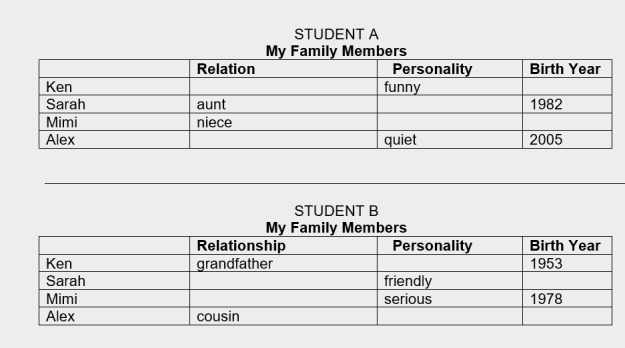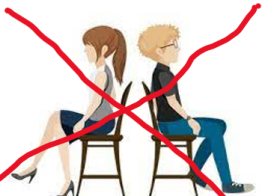
(This posting includes a handout which you are welcome to use with your students.)
You can see my video discussing Part 1 & Part 2 here: VIDEO Getting The Most Out of ESL Information-Gap Activities: Six Recommendations
At first glance, these activities can appear to be just a fun way for students to interact with each other. However, the more I’ve worked with and developed them, the more I realize what an effective skill-building tool they can be.
For this PART 1 posting, I’ll…
1) briefly review what an information gap activity is.
2) describe three important ways to make these most effective for students and the mistakes that teachers sometimes make with these.
In my next posting, PART 2, I’LL …
3) explain ways to customize them to review and reinforce vocabulary words and conversation strategies.
4) include more samples of these types of information-gap activities.
Here is an example of an information gap activity and a common mistake teachers make with them.
Students work in pairs with one being Student A and the other Student B. Each of them is given a chart, for example like these:

When doing activities like this, they CANNOT SEE each other’s paper, so they need to ask questions to fill in their missing information. For example, Student A might start by asking, “What is Ken’s relation to you?” and “What is Sarah’s personality like?”
Unfortunately, when the charts are designed like this, most students do this activity in an easy way that involves little need to really understand each other’s question. For example, Student A will start on the first row, then the second row, etc.

Notice: Student B probably knows that Student A’s first question will be, “What is Ken’s relationship to you?” followed by “What year was Ken born?” Student B doesn’t even have to hear the third question in order to answer the what Sarah’s personality is like: friendly. We can address this by making a simple change in the chart:
How to make this activity more effective. (First recommendation.)
We can indicate the order in which students should ask their questions by including a small number in each box.

By doing this, Student B must listen closely to Student A’s question because he/she has no clue about which box Student A will ask about next.
How to make this activity more effective. (Second recommendation.)
Needless to say, pairs of students will complete the activity of filling in their charts at different times. Thus, you want something that will keep them productively occupied while waiting for the other pairs to finish. A good way to do this is to include an exercise below their schedules or written on the board.

(In this link, you can download an expanded version of this “My Family Members” exercise to use with your students. (My Family Members Info gap complete activity PDF ) Also, in the link, you’ll see how I remind students of the expressions that they should use to show that they understand or don’t understand and to request a repeat.
How to make this activity more effective. (Third recommendation.)

I once attended a session at a conference for ESL teachers where the presenter was demonstrating how to use information-gap activities. To have the audience members experience these, he had us match up with a partner and sit back-to-back while doing the activities. I imagine that he was worried that we would “cheat” by looking at our partner’s paper. From this, I was able to experience first hand how hard it was to understand each other and how much was lost by not being able to have eye contact. It just seemed so unnatural and even physically uncomfortable. And on top of that, it was totally unnecessary.
I have found that if students understand that the purpose of these activities is to help them develop their language skills, and it is NOT SOME KIND OF GAME, they tend to see the absurdity of “cheating.” In other words, they don’t try to look at their partner’s paper.
When they finish filling in all the blanks, I usually see big smiles on the faces as they compare their charts and find out how well they were understood.
For another information-gap activity that includes an introductory exercise and Student A /Student B charts, see • Another Conversation Activity: Listen to Partner and Ask Questions to Complete Information-Gap Chart
In my next posting, PART 2, I’ll explain how we can customize these chart-type information-gap activities to review and reinforce vocabulary words and conversation strategies.
David Kehe
*About the free-download materials. During my 40 years of teaching ESL, I have had many colleagues who were very generous with their time, advice and materials. These downloads are my way of paying it forward.
Thank you for “giving back” such a useful resource at no cost. Your recommendations are really common sense that make so much sense. I look forward to trying this activity with my students.
LikeLiked by 1 person
It’s great to hear that it makes sense, Selena! I’d be very interested to hear how the activity works out for your students. Thank you for the comment!
LikeLike